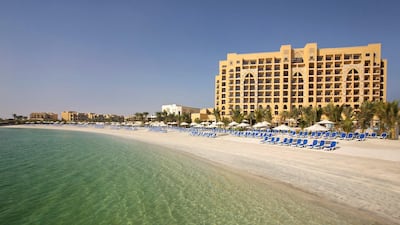Ras Al Khaimah expects a 20 per cent annual increase in the number of visitors to the emirate in 2021, driven by easing border restrictions in the second half of the year and robust domestic demand, its tourism development chief said.
The 2021 growth projection comes after the emirate hosted 830,000 visitors in 2020, down from 1.1 million in 2019, according to official government data.
The emirate is wooing new source markets in Europe and the Gulf to attract more tourists, increasing its hotel room supply, expanding its tourism investment budget, intensifying marketing efforts to draw remote workers and extending Covid-19 relief packages to the industry, Raki Phillips, chief executive of Ras Al Khaimah Tourism Development Authority, told The National.
"We live and survive off the international market and I'm cautiously optimistic that in the second half of the year the world is going to open up a lot more," Mr Phillips said.
"There's a lot of pent-up demand but when people want to travel, they're going to be limited in the options they can go to and the UAE will be front and centre because of how well we've handled the pandemic and because of how high our vaccination rates are."
The Covid-19 pandemic has hit global aviation and tourism industries hard, as border closures and quarantine requirements hammered demand. The UAE – a major tourism, trade and finance hub in the region – recorded a hotel occupancy rate of 51.7 per cent in 2020, a drop of 29.3 per cent from a year ago, according to a report by hospitality data and analytics specialist STR.
Revenue per available room (RevPar), a key performance metric calculated by multiplying a hotel’s average daily room rate by its occupancy rate, declined 41 per cent year-on-year to Dh216.45 ($58.90).
Ras Al Khaimah – which boasts the world's longest zipline at Jebel Jais, 64km of coastline, adventure tourism offerings and heritage sites such as Al Jazirah Al Hamra – has traditionally been popular with UAE residents and visitors from CIS markets.
"Occupancy in the UAE's top markets has improved significantly since the pandemic low points," Philip Wooller, STR's area director of Middle East & Africa, told The National. "Ras Al Khaimah remains an attractive staycation destination within the UAE."
The emirate recorded a 52.8 per cent occupancy and RevPar of Dh260.52 in February—the highest such levels for the market since December 2020.
The emirate is currently studying source markets with open borders and holding talks with Slovakia, Romania, Bulgaria and Poland to bring more tourists via chartered or scheduled flights, Mr Phillips said.
In terms of segments, it is targeting corporate retreats and meetings, incentives, conferencing and exhibitions travel from western European markets such as Italy and France, he said. However, some countries will take longer to re-open and the conferences segment travel is likely to recover more slowly, he added.
"There's been a tremendous amount of interest, especially for the incentives travel business," he said.
The emirate is looking to be a destination for weddings this year, after the pandemic forced couples to cancel or defer their celebrations due to restrictions on group gatherings.
"The area that I think RAK will do phenomenally well in is weddings," he said. "Once things open up and if we open with a market that wants to host weddings, I think you're going to see those coming in droves."
The government entity is extending a Covid-19 relief package to its tourism industry, allowing hotels to keep a portion of the Tourism Dirham tax until April 22 to bolster their cash flow, he said. It will also pay the cost of PCR tests for tourists staying a minimum of two nights in Ras Al Khaimah.
Last year, the authority introduced a tourism stimulus package including cash infusions, three-month relief on the Tourism Dirham tax and waived fees and fines.
Despite the ongoing pandemic, an additional 1,500 new hotel rooms will enter the market this year as the Hamptons by Hilton, Radisson, Movenpick and the Intercontinental open new properties in the emirate, he said.
"You build for the future," he said, when asked about the risk of oversupply.
The goal is to reach 10,000 hotel rooms in the next five years, up from 6,500 currently, he said. "If you take a snapshot of 2020 and base decisions just on that the industry will never survive. You base your decisions on how well the market did in a difficult time and you learn from it."
The emirate's 2021 tourism budget is "significantly" higher than last year as it invests in attractions, improving hiking trails, roads and infrastructure, he said, declining to reveal its size.
An eco-friendly hotel on Jebel Jais is in the design phase but an operator is yet to be named. More attractions will be announced this year, he said.
The emirate is diversifying the types of travellers it will attract, focusing on culture and heritage visitors, Gulf travellers, particularly from Saudi Arabia and Kuwait, and remote workers.
The Nomad programme, launched in the fourth quarter of last year to attract workers seeking to escape lockdowns with long-stay hotel packages, has garnered interest, he said.
The pandemic has brought the public and private sectors "much closer" to address the challenges, he said.
Already, Ras Al Khaimah is seeing tentative signs of a recovery in tourism with the return of visitors from the CIS markets, especially Russia, Mr Phillips said. An agreement with SCAT Airlines for direct commercial flights from eight cities in Kazakhstan starting this month is expected to draw more visitors.
Still, a return to pre-pandemic levels will take "a few years" due to a lack of common travel standards globally, he said.


























